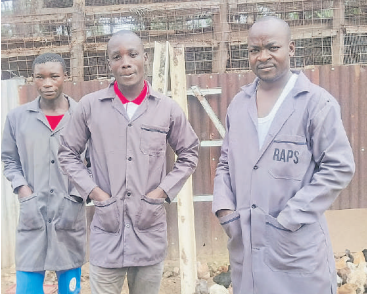
How KCB helped chicken farmer thrive in Kakuma
Mark Mwanyinywa had to rebuild his life from scratch in the refugee camp
Rough calculation gives Rapando a daily income of roughly Sh25,000 on a good day if he sells all his collections.
In Summary
 Farmhands Robinson Alex, John Maxwell and the entrepreneur John Rapando
at his poultry farm in Kakamega /HANDOUT
Farmhands Robinson Alex, John Maxwell and the entrepreneur John Rapando
at his poultry farm in Kakamega /HANDOUT
Imagine going to sleep at night after fully preparing how you will report to work in the morning, only to wake up jobless.
The company you worked for as of last night has closed down and only notified you through an SMS. That was the reality faced by John Rapando, 33, a Nairobi-based media practitioner.
It became a driving force behind his push to grow his sources of income, even though he was still determined to push on with his career.
Like many professionals in Kenya, journalists have had to explore alternative income streams to supplement their earnings amid challenges in the media industry.
Rapando says he found fortune in poultry farming after the Covid-19 pandemic disrupted his primary revenue streams.The Covid-19 pandemic hit hard, affecting multiple sectors, and the media industry was not spared.
As companies struggled to stay afloat, job security became uncertain, prompting many professionals, including Rapando, to seek alternative sources of income.
Having always harbored an interest in agribusiness, he saw an opportunity in poultry farming and decided to take a bold step into the venture post-pandemic.
“I had to make a decision and dedicate time and resources to the idea, which has now become a reality and a major income-generating activity for me,” he said.
With a modest investment of Sh30,000 from his savings, he transitioned from solely relying on his media career to becoming a thriving poultry farmer, an endeavour that now serves as his main source of income.
“I took time to plan this side hustle carefully,” Rapando told said during an interview with the Star, “I started in early 2023. It grew fast and in 2024, I had to expand it and open up the farm.”
The startup capital enabled him to buy 50 layers and set up a simple structure for them. His rural home provided some readily available building materials, reducing the initial costs significantly.
“My poultry farm has expanded today.I have 2,500 layers that produce several trays of eggs per day, which is about 2,000 eggs daily.”
A rough calculation gives a daily income of roughly Sh25,000 on a good day if he sells all his collections.
Rapando says poultry farming is an attractive venture due to its relatively low space requirements compared to other livestock.
“Chicken are highly adaptable to different environments making them easy to manage and sustain. They adapt easily, grow fast and the output can be good as long as they are fed well and taken good care of daily,” he says.
The entrepreneur says his success in poultry farming has not gone unnoticed. With the steady expansion of his business, he is securing loans and attracting support from investors keen on poultry farming.
Rapando says this financial boost has fuelled his ambition to scale up production, with a target of reaching 10,000 chickens by this year.
The journalist-cum-entrepreneur, who hails from Mumias West constituency, Kakamega county, says he has had to travel every weekend from Nairobi to go and assess the progress of his investments. He says the level of hygiene required for his kind of investment is high as the chicken require to be treated twice every month.
Moreover, proper housing, timely vaccination and hygiene are crucial in poultry production. But unlike many smallholder poultry farmers who make their feeds, Rapando buys all his feeds from millers, which according to him makes the production process easier.
Feed production, he said, is a complicated process, where quality assurance matters a lot to ensure consistent quality. Besides feeds, one needs good capital for raw materials and equipment, which is financially strenuous.
To oversee this, he says he was forced to hire eight youths directly to help him in in supplying the eggs around Kakamega.
Egg prices fluctuate due to an influx of eggs from Uganda and Tanzania, which poses a challenge. Rapando advises those planning to join the trade to first get knowledge on poultry farming.
According to Farming in Kenya Consultancy, the country’s poultry industry has grown significantly, boosting its agricultural GDP. By 2024, Kenya had around three million small poultry farmers and 50 million birds. This number includes chickens, ducks and turkeys, with chickens being the most common at 45 million.
The poultry sector contributes nearly three per cent to Kenya’s GDP. Its growth is driven by several factors.
Animal welfare crusaders, however, vouch for free-range poultry farming instead of battery cage systems.Feeds, according to the entrepreneur, account for about 98 per cent of the total production cost.
If the birds are well fed, they give the right size of eggs, he said. Rapando said a good chicken should give 340 eggs a year, and then it should be replaced after 18 months. The demand for chicken has been on the rise in the country.
For instance, chicken topped the orders list as the most ordered item, according to the Bolt Food platform, with customers requesting the dish more than 30,000 times throughout the year.
Meanwhile, about 50 million birds are slaughtered in Kenya annually, with 92.6 per cent of the population frequently eating chicken, reports the Food and Agriculture Organisation.
The organisation also reported that at least 45 million Kenyans frequently eat chicken, with 27.6 per cent of the population eating a meal with chicken weekly.

Mark Mwanyinywa had to rebuild his life from scratch in the refugee camp